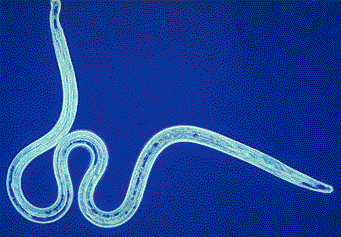摘要:国家疾病过敏感染卫生院的研究小组领导托马斯乙称:已完成了寄生虫 Brugia malayi 的大部分的蛋白分析,这一寄生虫可引起下肢浮肿,形状似大象腿。

马来布鲁线虫 Brugia malayi 图
A team led by Thomas B. Nutman, M.D., of the National Institute of Allergy and Infectious Diseases (NIAID), part of the National Institutes of Health, has completed a large-scale analysis of most of the proteins produced by Brugia malayi, one kind of parasitic worm that causes lymphatic filariasis, or elephantiasis. The greatly swollen lower limbs that can result from chronic infection with this mosquito-borne parasite can be severely disabling.The investigators characterized 7,103 proteins produced in various stages of the worm's lifecycle, including male and female adult forms that live in the body's lymphatic system; asexual stages that circulate in human blood; and the larval stage that first infects humans.
The nature and relative amounts of proteins produced during successive stages of the worm's lifecycle provide clues to their likely importance in creating and maintaining infection. For example, proteins made in abundance by larval worms might serve as targets for developing vaccines to prevent infections. Proteins made in large amounts by adult worms might serve as targets for developing drugs to treat infections and potentially halt transmission of the parasite from an infected person to a potential mosquito carrier.
In addition to identifying the worm-made proteins, the team also characterized most of the proteins made by Wolbachia, bacteria that live inside B. malayi. Human inflammatory immune responses to the combined presence of Wolbachia and B. malayi are thought to be responsible for many symptoms of lymphatic filariasis.
Sequencing of the B. malayi genome, which enabled this research on the worm's proteins to be carried out, was completed by National Institutes of Health-funded researchers in 2007.







